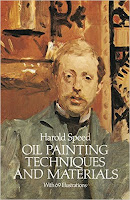 Welcome to the GJ Book Club. Today we'll cover pages 187-192 of the chapter on "Tone and Colour Design," from Harold Speed's 1924 art instruction book Oil Painting Techniques and Materials
Welcome to the GJ Book Club. Today we'll cover pages 187-192 of the chapter on "Tone and Colour Design," from Harold Speed's 1924 art instruction book Oil Painting Techniques and MaterialsI'll present Speed's main points in boldface type either verbatim or paraphrased, followed by my comments. If you want to add a comment, please use the numbered points to refer to the relevant section of the chapter.
1. Gradated and Flat Tones
Speed covered this topic in his book on drawing as well. He suggests planning the picture in flat tones and to "let your gradations be the result of such tones melting into each other where necessary." Form that is conceived in planar terms has more vigor, he argues, compared to smoothly curving form, which can start looking effete or feeble.
 |
| Turner - Norham Castle Sunrise |
Speed says that a good place to put gradations is in the edges between the big flat shapes. "The larger the number of these lost edges the more gracious the expression, and the larger the number of hard edges, the more forceful and less gracious the expression." As with all painterly aesthetics, an intelligent mix of both is the best bet.
3. Range of Tone
Here's another principle: "The smaller the range of tone used, the quieter and more peaceful the result." In the Turner sunrise painting, the values are kept close and the edges are kept soft, creating a gentle effect, like a shimmering tremolo on the violin. Note that he didn't use pure white for the sun, but shifted hue and chroma from a light gray sky to a high-chroma yellow sun. The piece is high in key and is saved by the solitary dark accent of the cow (or is it a horse? I can't tell).
Whether Turner pushes his effects too far in his late work is a matter of taste; I prefer his earlier work where the effects are more understated. I think Frederic Church is better at Turner than Turner is.
The reverse is also effective: a mostly dark painting with a single light accent, as with the Bierstadt nocturne below:
 |
| Bierstadt Ships at Night |
 |
| Giorgione's Holy Family with Saints |
Note the central position of the Madonna, but the varied handling of the flanking figures.
5. Giorgione's Fête Champêtre (Pastoral Concert)
Speed admires the wide range of tone without dramatic edge contrasts. Contrast between gentle form modeling on figures to staccato accents on the drapery.
6. Poussin's Flight into Egypt
Speed seems to greatly admire this painting. He analyzes the piece by sketching a tone plan and a diagram of line rhythms, and he breaks down the composition in tonal terms. Personally, I don't see this as being a very exemplary work. It has so many confused centers of interest and awkward, stiff passages. What is the baby Jesus most worried about: the concrete clouds, the heavy handed foreshadowing, or his distracted parents? Sorry, I've just never been a big fan of Poussin.
 Next week—We'll continue with the Veronese on page 192.
Next week—We'll continue with the Veronese on page 192.
-----
In its original edition, the book is called "The Science and Practice of Oil Painting ." Unfortunately it's not available in a free edition, but there's an inexpensive print edition that Dover publishes under a different title "Oil Painting Techniques and Materials
." Unfortunately it's not available in a free edition, but there's an inexpensive print edition that Dover publishes under a different title "Oil Painting Techniques and Materials (with a Sargent cover)," and there's also a Kindle edition.
(with a Sargent cover)," and there's also a Kindle edition.
----GurneyJourney YouTube channel
My Public Facebook page
GurneyJourney on Pinterest
JamesGurneyArt on Instagram
@GurneyJourney on Twitter









14 comments:
Poussin is an acquired taste.
Poussin is an acquired taste.
Interesting posts as always.
Dont know if you know of The Internet Archive
figured if you dont you or your readers might enjoy it,
great inspiration and research.
http://maaskeikke.tumblr.com/post/141620162848/resources-from-the-past
Took some screenshots of a "few" cool things i have found :)
Cheers and good weekend
James: Here's the Wikicommons version of that Giogione painting:
https://commons.wikimedia.org/wiki/File:Giorgione,_Madonna_with_the_Child,_St_Anthony_of_Padua_and_St_Roch.jpg
Kurt, thanks, I've added the Wikicommons version (without the watermark) to the post.
Jesper, that's an amazing resource. Thanks so much
Steven, I guess so. I'm always ready to be inspired. I suppose it helps to see the originals, too. There are a lot of artists that don't really translate well to computer screens.
Very, very sadly, The Internet Archive is blocked in our country. I am really disappointed.. But thanks for the resource, Jesper.
And I am really sorry that I cannot contribute in this wonderful book club: I, of course, cannot find this book anywhere, as you've probably guessed it. But I still enjoy it. Thank you. (off-topic, big wall-like comment again!)
James, Happy you could use it.
HNK, You can use a VPN site like https://hide.me/en/proxy to get around region blocks on sites, just don't use it where you need to input personal data, just to be safe.
I forgot this option. Thank you, Jesper. I'll try that.
Amazing Resource Jesper! Thanks!
As for the chapter, I agree with James on Poussin's. I am not a big fan of those thick clouds, especially, and I would rather go for "gradations only" like Turner instead of none, like Poussin
Well, I still am a "fan"...erhhh a somewhat (oldspeak) "admirer" of Poussin.
There's a calm strength in his compositions, a sense of overall unity. He's just "classical", IMO.
Although good old Cezanne (Poussin admirer like Delacroix and a host of others) must also have objected to those "concrete clouds":-) He is quoted to have said that
"he wished to do Poussin again after nature."
May be to late to comment, but the animal in the foreground is a cow. Cows have very flat backs, horses a gentle curve. Horses also have strong curving hindquarters where cows have a sharp angle. The cows shoulder is also angular and there appears to be a dewlap below the neck. Horses overall seem to be very curvy and feminine in their build whereas cows are more angular and masculine.
Not a particularly profound comment on such a lovely painting, but just an observation.
A couple of years ago, that Giorgione painting made it to Melbourne. It was one of the most beautiful works I've ever seen and I had my nose pressed into the varnish for the longest time. I felt it was unfinished or perhaps too rigorously cleaned at some point in its history. It is very thinly painted in parts with large unmodulated passages of thin flat tone. It gave the impression of a wash-in. The figure on the left is a friend of the family and doing well in hospitality...an unbelievable likeness!
...and James...don't go dissing the Poussin....
:)
Rich said ... There's a calm strength in his compositions, a sense of overall unity. He's just "classical"
Well said ... it took me a long time to appreciate Poussin, but once there, there's no going back ... As I said above he's an acquired taste, and well worth putting in the time to do so.
Post a Comment